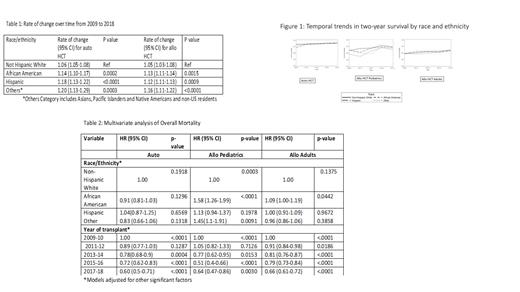Abstract
Background
There has been an increase in overall utilization as well as improvement in overall survival (OS) after hematopoietic cell transplantation (HCT) for most hematologic disorders over time. It is not known if these changes have impacted racial/ethnic minorities equally. In this study, we describe changes in the volume and rate of autologous (auto) and allogeneic (allo) HCT and examine trends in survival in different racial/ethnic groups from 2009 to 2018.
Methods
Data were obtained from the Center for International Blood and Marrow Transplant Research (CIBMTR) which collects patient data on most autologous and allogeneic HCT recipients in the US. We compared the number of auto and allo transplants in 4 different racial/ethnic groups: Non-Hispanic Whites (NHWs), African Americans (AAs), Hispanics and 'Others' across five 2-year cohorts from 2009 to 2018. 'Others' included Asians, Pacific Islanders and Native Americans as well as non-US residents. Since numbers in individual categories were too low to be meaningful, they were grouped together as 'Others'. Multi race individuals and those with either race or ethnicity missing were excluded. Cox proportional hazards models were used to examine trends in overall mortality after auto HCT in adult patients (for NHL, HD, and MM), and allo HCT among adult and pediatric patients (for AML, ALL, lymphoma including chronic lymphocytic leukemia, and MDS/MPD) in the 4 different racial ethnic groups over 5 study time periods. These models were adjusted for sociodemographic and clinical variables (age, sex, Karnofsky/Lansky score, HCT-comorbidity index, disease, disease status, geographic region, insurance, marital status, education, distance to the transplant center, median income derived from patient's ZIP code). Graft type, donor, conditioning, GVHD prophylaxis, donor-recipient CMV match and donor-recipient sex match were included for allo HCT models.
Results
A total of 80,080 (59,666 NHWs, 10,683 AAs, 7,110 Hispanics) patients received an auto HCT and 60,412 (44,272 NHWs, 4,964 AAs, 7,826 Hispanics) received an allo HCTs from 2009 to 2018. The volume of auto and allo transplants increased overall, as well as within each race/ethnicity group, over the study periods. In addition, there was a significant change in the proportion of patients in each racial/ethnic group undergoing an auto HCT, with a lower proportion of NHWs and increased proportion of minorities over time (from 78%, 12% and 8% in 2009 -2010 to 71%, 15% and 10% in 2017-2018 for NHWs, AAs and Hispanics respectively; p<0.001). Similar trends were observed for allo HCT: from 76%, 8% and 12% in 2009-2010 to 71%, 9% and 14% in 2017-2018 of all allo HCTs for NHWs, AAs and Hispanics respectively; p<0.001. While there was an increase in the rate of transplants over the years across all racial/ethnic groups, the rate was higher in AAs and Hispanics as compared to NHWs (Table 1).
There was no significant difference in overall mortality amongst the three main racial ethnic groups, though there was decrease in mortality over time for auto HCT and adult allo HCT patients. In the allo HCT pediatric group, AAs had higher overall mortality as compared to NHWs across all time periods. (Table 2) Figure 1 shows temporal trends in two-year survival by race and ethnicity.
Conclusions
This large population-based study shows an improvement in the rates and survival of auto and allo HCT in adults over time. Changes in the proportion of different racial/ethnic groups undergoing HCT are higher than rate of change of population growth (3% decline for NHWs, no change in AAs and 2% increase in Hispanics from 2010 to 2019 per William H. Frey analysis of census population estimates released June 25, 2020). Progress is reflected in higher rates of increase in racial/ ethnic minority groups and comparable survival across the racial ethnic groups in our cohort as compared to two prior registry studies (Baker et al. JCO 2005 and Baker et al. BBMT 2009) for most HCT patients. However, in pediatric patients undergoing allo HCT, the gap in survival between NHWs and AAs has continued to persist over the years. With increasing diversity of the US population, we need to strengthen our efforts for improving access to, and outcomes of HCT to narrow the gap for all patients requiring HCT, irrespective of their sociodemographic characteristics.
Wood: Koneksa Health: Consultancy, Current equity holder in publicly-traded company; Teladoc: Consultancy; Pfizer: Research Funding. Ailawadhi: Karyopharm: Consultancy; AbbVie: Consultancy; Genentech: Consultancy; Takeda: Consultancy; GSK: Consultancy, Research Funding; Xencor: Research Funding; Cellectar: Research Funding; Medimmune: Research Funding; Ascentage: Research Funding; Pharmacyclics: Consultancy, Research Funding; Amgen: Consultancy, Research Funding; Janssen: Consultancy, Research Funding; Bristol Myers Squibb: Consultancy, Research Funding; BeiGene, Ltd.: Consultancy; Sanofi: Consultancy; Oncopeptides: Consultancy. Saber: Govt. COI: Other.


This feature is available to Subscribers Only
Sign In or Create an Account Close Modal